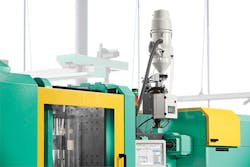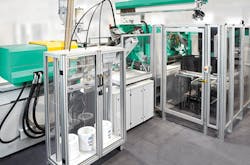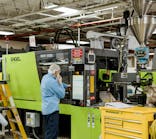Injection molding machinery maker Arburg GmbH + Co. KG, Lossburg, Germany, now offers three processing approaches that allow for the lightweight construction of automotive and industrial parts with an opportunity to include value-added functionality.
Heinz Gaub, managing director of technology and engineering, presented the technologies during the June inauguration of the headquarters of the company's U.S. division, Arburg Inc., in Rocky Hill, Conn. Arburg says the developments were driven through extensive cooperation with innovative partners and the integration of their R&D networks.
FOAM INFUSION
Arburg's new ProFoam process differs from the better- known MuCell technology by Trexel Inc., Wilmington, Mass., in that the propellant gas is infused into the polymer before the material enters the injection press, rather than a supercritical fluid being introduced into the material during the plasticating and injection phase.
ProFoam is designed to improve the mechanical properties of foamed parts while eliminating the need for specialized equipment, changes to the processing screw or more involved processing steps.
"The technology is easier than competing foaming processes and has no mixing and shearing zone in the screw," Gaub said. "It can reduce the occurrence of sink holes, shrinkage and distortion of a part, and trim material consumption while reducing cycle times and unit costs. A new application of ProFoam is being tested and will be shown by Arburg at the Fakuma show later this year."
ProFoam was developed through joint research by Arburg and the Institute for Plastics Processing (IKV) in Aachen, Germany. A homogeneous, gas-filled polymer compound is produced on a conventional injection molding machine prior to injection by replacing the feed hopper with a patented granulate lock mechanism.
The granulate lock is a two-chambered unit that receives feed material, then seals the feed port with an air lock. The gas propellant, carbon dioxide or nitrogen, is introduced into the lowest chamber of the granulate lock. The resin then drops from the upper chamber to the lower chamber. The propellant creates a gas atmosphere up to 50 bar. The propellant is infused into the pellets in the sealed chamber.
An air lock is installed between the sealed chamber and the plasticizing unit. The injection press is equipped with a needle-type shut-off valve on the front end, while the screw is fitted with a seal on the back end.
The granulate lock and the gas-propellant delivery system are the only peripherals required. The gas-infused pellets can be processed on a conventional injection unit with a three-zone plasticizing screw and typical process temperatures. Just one additional setting parameter on the controller — regarding liquid propellant pressure — is required to run the process.
Gas expansion leads to foaming of material at holding pressure with volumetric filling, Arburg says.
The process results in a lighter-weight, stable part with low distortion that has a homogeneous foam structure (foamed cells are closed and similar in size to those produced through the MuCell process), says Arburg. ProFoam is suited for use with thermally sensitive materials with a low melt temperature. Fiber-reinforced materials can be processed with a conventional screw without additional shearing.
At its Technology Days event earlier this year at its headquarters in Lossburg, Arburg demonstrated ProFoam, producing an automotive air bag housing made from glass-filled PP. The 272-gram, 280mm-long part was produced in 1 minute, 10 seconds. The ProFoam part was 18 percent lighter than the conventionally molded 330-gram part made without physical foaming, yet exhibited similar mechanical properties.
BONDING A FOAMED PART
TO THERMOPLASTIC
Arburg's Particle-foam Composite Injection Molding combines a foamed structure with an injection molded structure to create a fully functional, lightweight hybrid part in a single step. This eliminates downstream assembly, which can be a more cost-effective approach to producing a multi-material part. PCIM was developed by Arburg with foaming technology supplier Ruch Novaplast GmbH + Co. KG, Oberkirch, Germany, and toolmaker Krallmann Group, Hiddenhausen, Germany.
The composite part is produced using expanded PP or expanded PS to create what Arburg calls particle foam. That particle foam is transferred by robot into an injection press where a precisely formed insert thread made from a conventional thermoplastic is molded into or onto the particle foam part. The materials are selected so that the surface of the EPP or EPS component melts in a defined manner to the molded structure, creating a bond between the two components that is strong and permanent, says Arburg. Specialized technology is required to introduce the particle-foam part into the mold reliably and without deformation or damage.
The foamed, low-weight component of the part provides insulating and soundproofing characteristics while the solid thermoplastic provides mechanical strength and high volumetric weight. Processors can evaluate various combinations of particle foam and thermoplastics that eliminate the disadvantages of each material. Users can produce strong items with low weight, energy-absorbent parts with attractive tactile surfaces and insulated lightweight parts with enhanced rigidity or with integrated mounting and holding functions.
Arburg has demonstrated PCIM, for example, combining a 357-gram EPP part with a 52.5-gram PP element to produce a door cladding with integrated mounting. The foaming step took 5 minutes, 20 seconds, while injection molding required 45 seconds.
FIBER DIRECT COMPOUNDING
AND ORGANIC SHEETS COMBINED
Arburg's Fiber Direct Compounding (FDC) process is designed as a metal-replacement technology initially targeting automotive applications. Arburg has raised the potential number of applications with FDC processing by incorporating high-strength, pre-cut organic sheets that are overmolded to the part.
Arburg's FDC process is an at-the-press technology developed with SKZ German Plastic Center in Würzburg. It produces a reinforced material that incorporates fiber strands into the melt during plasticating, eliminating the use of a compounding unit or pre-compounded pellets.
Key to the FDC process, which Arburg uses for long-fiber direct injection molding (LFDI), is the use of an Arburg-developed servo-electric side feeder that mounts onto an Arburg press and can incorporate fiber strands from 0.6 to 2 inches into the plastic melt. The glass fiber is supplied as rovings that are cut at the machine to a desired length then introduced into the primary processing unit through the side feeder. Compounding the fibers into the melt at the press allows for the use of lower-cost base materials and creates an opportunity for custom resin formulations.
"Part properties can be influenced in a more targeted way through the individual adjustment of fiber lengths, fiber content and material combinations," says Gaub.
FDC yields parts with longer fiber lengths that deliver better mechanical properties compared to pre-compounded glass-fiber- reinforced thermoplastics, which typically have a starting fiber length ranging from 0.3mm to 6mm. Users can adjust the length of the fibers while minimizing fiber damage during handling. With a pre-compounded pellet, the injection process breaks the fibers during processing, yielding parts where about 30 percent of the fibers are longer than 2mm.
"A noticeable effect on part strength and toughness is achieved with fibers exceeding a length of 2mm. Distortion, creep and energy absorption properties [of an FDC-made part] are similar to those of metals," says Gaub. The benefit is that the thermoplastics provide weight reduction without compromising load-bearing capacity, Gaub says.
The FDC process can start with fibers that are 16mm long, yielding parts where 50 percent of the fibers are longer than 2mm after injection. Arburg's injection unit features a special two-stage screw where the polymer is melted in the first stage then conveyed to the front of the unit, where the fibers are introduced into the melt system by the side feeder. The polymer-fiber compound is gently homogenized by the screw prior to injection. This yields parts with a higher percentage of longer fiber lengths.
Physical and mechanical properties are enhanced as fiber lengths reach beyond 2mm, according to Gaub. Arburg says a 30 percent glass- reinforced PP part with rovings incorporated by FDC costs about 45 percent less in series production than molding parts from a pre-compounded 30 percent glass-filled PP pellet.
In an extension of the FDC process, pre-cut thermoplastic sheet in woven and nonwoven form, containing glass, carbon or aramid fibers, can be added to the process part in selected areas and overmolded in a specially designed mold to produce a higher-strength, lightweight composite part. Arburg demonstrated the combination technology at its June event producing an automotive brake pedal featuring two pre-cut organic sheets of differing geometries and thicknesses molded over a 30 percent glass-filled PP, with the long-fiber rovings and bonding agent added.
The 19.7-inch pedal produced with the composite materials was manufactured in a 50-second cycle time, weighing in at 17 ounces. If made from metal, the same part would weigh 18.8 ounces and take several manufacturing steps to produce, Gaub said. In addition, load failure of the composite part with the thermoplastic sheet is improved 117 percent in comparison to a metal part. The relatively short cycle time paves the way for commercial production of high-volume lightweight parts.
The organic sheets are handled using a six-axis robot that has a heater plate on the gripper. The robot gripper heats the sheet on one side after it picks the sheet from the magazine. An infrared radiator placed in the work cell carries out primary heating of the organic sheet, heating the other side of the sheet.
The high temperatures of the sheet and the resin ensure a strong mechanical bond. Forming of the sheet and overmolding take place in a special Lightweight Integrated Process Application mold, says Arburg. Arburg molded the part on an Allrounder 820 S servo-hydraulic machine. LFDI molding can be used with any Allrounder model with a clamping force from 275 to 440 tons, says Arburg. Users can convert the machine for conventional molding by swapping out the thermoplastic cylinder.
Mikell Knights, senior correspondent
Contact:
Arburg Inc., 860-667-6500, www.arburg.com








